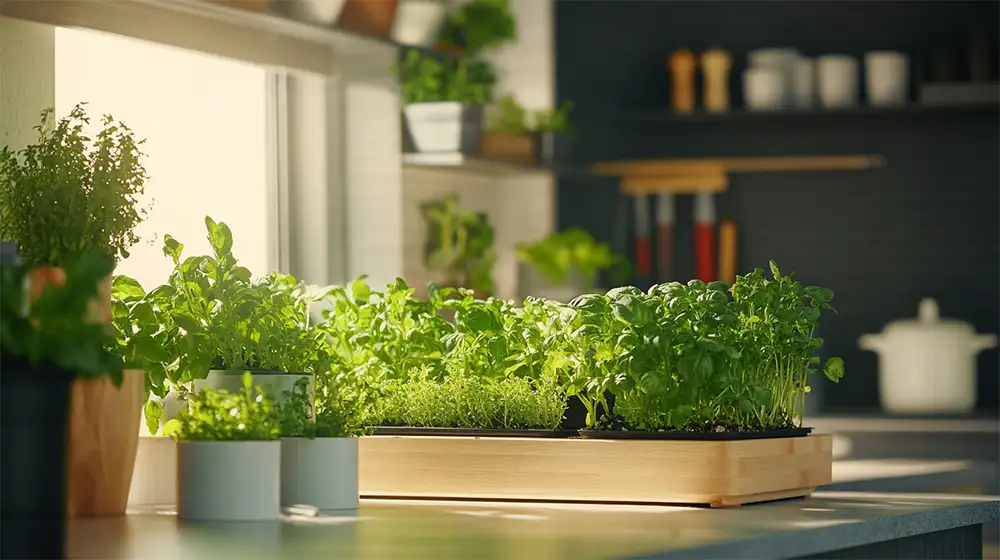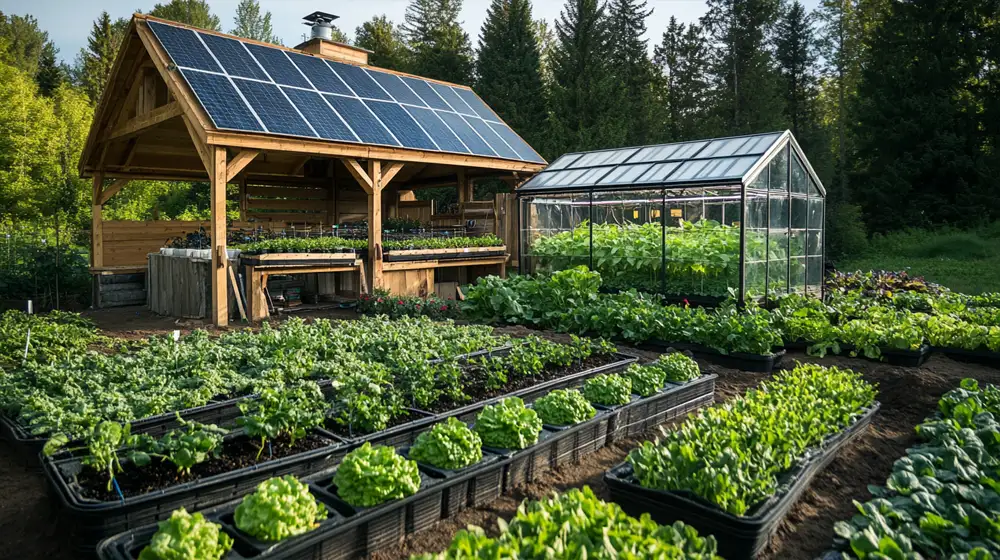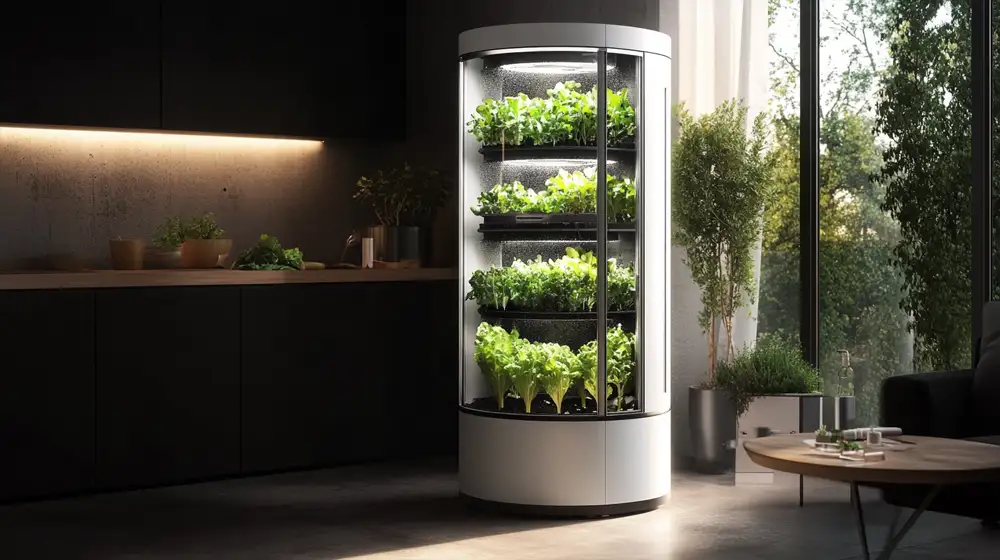
In an era where sustainability, efficiency, and self-sufficiency are not just ideals but necessities, hydroponics emerges as a revolutionary approach to growing food. Far removed from the traditional image of vast fields and muddy hands, hydroponics offers a clean, controlled, and remarkably productive method of cultivating plants without soil. This innovative practice involves growing plants in nutrient-rich water solutions, allowing for unparalleled control over their environment and growth.
For homeowners, whether connected to the grid or aspiring to an off-grid lifestyle, hydroponics presents a compelling vision of food freedom. Imagine harvesting crisp lettuce in the dead of winter, juicy tomatoes year-round, or fresh herbs directly from your living space, all while using a fraction of the water and land traditional gardening demands. The allure of hydroponics lies in its promise of quicker yields and the profound control it grants over every aspect of a plant's development, from nutrient intake to light exposure and temperature. This comprehensive guide will delve into the various hydroponic methods, their intricate workings, individual pros and cons, practical considerations, and potential costs, all while tailoring insights for both the urban dweller and the self-reliant homesteader. We'll also explore how local environmental conditions—such as temperature, sunlight availability, and humidity—play a pivotal role in system selection and success, ensuring your hydroponic journey is both productive and sustainable. Get ready to transform the way you think about growing food, making Fresh, vibrant produce a consistent reality in your home.
The fundamental premise of hydroponics is deceptively simple: provide plants with everything they need directly at their roots, bypassing the need for soil. This direct delivery of water, oxygen, and mineral nutrients unlocks a cascade of benefits that traditional gardening simply cannot match. For both on-grid homeowners seeking fresh, convenient produce and off-grid homesteaders striving for ultimate self-sufficiency, hydroponics offers transformative advantages that redefine food production.
One of the most compelling benefits of hydroponics is its unmatched water efficiency. Traditional agriculture is a notorious water guzzler, with much of the water lost to evaporation, runoff, or absorption by soil. Hydroponic systems, particularly closed-loop designs, recirculate water, leading to a staggering 70% to 90% reduction in water usage compared to conventional farming. For an off-grid homestead where every drop of water is precious and often manually sourced or collected, this efficiency is not just an advantage—it's a game-changer. It means more food can be produced with less strain on limited water resources, improving resilience and sustainability.
Beyond water savings, hydroponics consistently delivers quicker yields and higher production rates. By supplying nutrients directly to the root zone in optimal concentrations, plants don't have to expend energy searching for food in the soil. This enables them to dedicate more energy to vegetative growth and fruit production, leading to faster maturation cycles and often, larger harvests. This accelerated growth translates to more frequent harvests, ensuring a continuous supply of fresh produce for your family. For off-grid scenarios, this means achieving food security faster and more reliably, reducing dependence on external food supply chains and buffering against seasonal fluctuations.
The elimination of soil is another monumental advantage. Soil can be a breeding ground for pests, diseases, and weeds, requiring laborious and often chemical-intensive interventions. In a hydroponic system, these issues are drastically minimized. Without soil, there are no soil-borne pathogens or weeds to contend with, leading to healthier plants, less maintenance, and a reduced need for pesticides or herbicides, making your produce cleaner and safer. For someone looking to manage their resources efficiently on a homestead or in a busy household, eradicating these common gardening frustrations saves time, money, and effort.
Perhaps the most empowering aspect of hydroponics, especially for the discerning gardener, is the full control it provides over plant growth. Every variable critical to plant health—nutrient concentration, pH levels, dissolved oxygen, temperature, and light exposure—can be precisely monitored and adjusted. This level of precision allows growers to fine-tune the environment to meet the exact needs of specific plants at different stages of their life cycle, optimizing growth, flavor, and nutritional content. This complete control makes hydroponics incredibly adaptable; you can grow fresh vegetables, herbs, and even some fruits year-round, regardless of external climate conditions. For off-grid living, this means reliable food production even in extreme weather, during droughts, or in inhospitable terrains that would never support traditional farming. Couple this with artificial lighting, and your indoor hydroponic garden becomes a bastion of consistent, high-quality food production, powered perhaps by solar panels, enhancing self-reliance and independence.
Finally, hydroponics excels in optimizing space. Systems can be designed vertically, drastically increasing the yield per square foot compared to horizontal soil plots. This vertical farming capability makes hydroponics ideal for homes with limited yard space, urban environments, or for consolidating food production within an off-grid shelter. Whether it's a small corner in an apartment or a dedicated grow room on a homestead, hydroponics maximizes output from minimal footprint, making it a sustainable choice for concentrated food production.
Considering these profound benefits—superior water efficiency, accelerated growth and yields, freedom from soil-related issues, total environmental control, and efficient space utilization—it becomes clear that hydroponics isn't just a gardening trend; it's a cornerstone of sustainable, self-sufficient living, equally valuable to the metropolitan homeowner and the pioneering homesteader.

The world of hydroponics encompasses a diverse array of systems, each with its unique mechanics, benefits, drawbacks, and ideal applications. Understanding these differences is crucial for selecting the method that best suits your goals, budget, available space, and the types of crops you wish to grow. Here, we delve into some of the most popular and effective hydroponic systems, outlining their operations, pros, cons, typical costs, and the crops they are best suited for.
1. Wick System: The Simplest Entry PointThe wick system is arguably the most basic and passive hydroponic method, making it an excellent choice for beginners and those uninterested in complex setups or reliance on electricity. It functions by using a "wick" (typically nylon rope or felt) to draw nutrient solution from a reservoir up into a growing medium (like perlite, vermiculite, and coco coir) where the plant's roots are located. Capillary action is the driving force, slowly delivering water and nutrients to the plants.
How it Works:Plants are placed in a growing tray filled with an inert medium, with wicks extending from the bottom of the tray into a nutrient solution reservoir below.
Pros:Extremely simple to set up and operate; no pumps, electricity, or timers required; very low initial cost; minimal maintenance once established.
Cons:Slower growth rates compared to active systems; limited oxygenation to roots; not ideal for large or thirsty plants; wicks can sometimes clog or suffer from nutrient buildup.
Ideal Crops:Small, non-fruiting plants with low water and nutrient demands, such as leafy greens (lettuce, spinach), herbs (basil, mint, cilantro), and small flowers.
Cost Considerations:Very low. You can construct a DIY wick system with common household items like plastic containers and old t-shirt strips for wicks, making it incredibly accessible for off-grid experimentation. Commercial kits are also inexpensive.
DWC, also known as the raft system, is another popular and relatively simple method known for its rapid growth rates, particularly for leafy green vegetables. In a DWC system, plants are suspended in net pots with their roots submerged directly into a reservoir of nutrient solution. An air pump and air stone are crucial for oxygenating the solution, preventing root rot and ensuring optimal nutrient absorption.
How it Works:Plants sit in net pots, supported by a lid or raft, above a reservoir where their roots hang freely in the oxygenated nutrient solution. Bubb les from an air stone provide essential oxygen.
Pros:Very fast growth; simple setup and operation; roots have constant access to nutrients; relatively low initial cost; excellent for leafy greens.
Cons:Highly dependent on constant oxygenation (risk of root rot if air pump fails); temperature control of the water is essential (high temperatures reduce oxygen); pH can fluctuate quickly; limited for larger, fruiting plants which may require more structure.
Ideal Crops:Excellent for lettuce, kale, spinach, basil, and other leafy greens. Some small fruiting plants like strawberries can also thrive.
Cost Considerations:Low to moderate. Requires a reservoir, net pots, an air pump, air stone, and tubing. Electrical power is necessary for the air pump, which requires off-grid energy planning (solar, battery) for homesteaders.
NFT is a highly efficient active system often seen in commercial hydroponic farms due to its water and nutrient efficiency. In an NFT system, a continuous, very thin film of nutrient solution flows over the bare roots of plants, providing them with water, nutrients, and oxygen. The channels holding the plants are typically sloped to allow gravity to return the excess solution to a reservoir, where it is then recirculated.
How it Works:Plants are placed in channels with a slight incline. A pump delivers a thin film of nutrient solution from a reservoir to the higher end of the channels, which then flows over the roots and drains back into the reservoir.
Pros:Highly efficient use of water and nutrients; excellent oxygenation for roots (as only a thin film touches them); relatively fast growth; scalable for commercial operations; easy to monitor nutrient solution.
Cons:Very susceptible to pump or power failure (roots can dry out quickly); requires precise channel slope and flow rate; root matting can occur, blocking channels; not suitable for large, heavy root vegetables.
Ideal Crops:Best for fast-growing, leafy greens like various types of lettuce, spinach, bok choy, and herbs. Strawberries and some small peppers can also do well.
Cost Considerations:Moderate to high. Requires a pump, channels, reservoir, and a reliable power source. The precision required in construction can add to DIY complexity, making ready-made systems a more appealing but costlier option. For off-gridders, a robust and redundant power system is crucial.
Ebb and Flow, also known as Flood and Drain, is a popular and versatile hydroponic method that involves intermittently flooding a growing tray with nutrient solution and then allowing it to drain back into the reservoir. This cycle ensures that plant roots are thoroughly watered and fed, and then exposed to air for optimal oxygenation as the water recedes. Plants are typically grown in an inert medium like rockwool, coco coir, or hydroton (clay pebbles) in the growing tray.
How it Works:A submersible pump floods the grow tray from a reservoir at timed intervals. Once the tray is flooded, the pump turns off, and gravity allows the solution to drain back into the reservoir.
Pros:Provides excellent root oxygenation due to the timed flooding and draining cycles; versatile for a wide range of plants and growing media; relatively easy to set up and manage once the timer is configured; large growing areas can be managed by a single reservoir.
Cons:Very susceptible to power outages (roots can dry out quickly); pump failure can lead to plant death; requires a reliable timer; risk of root rot if flood cycles are too frequent or drainage is poor.
Ideal Crops:Highly versatile for many crops, including leafy greens, herbs, peppers, tomatoes, cucumbers, and even some root vegetables like radishes (depending on container size), as it accommodates a wider range of plant sizes and root structures.
Cost Considerations:Moderate. Requires a pump, timer, reservoir, growing tray, and growing media. Power consumption is intermittent but essential during flood cycles. This system's flexibility makes it a good long-term investment for diverse crop production.

As you become more familiar with the foundational hydroponic methods, the world of advanced systems opens up possibilities for even greater efficiency and specialization. Beyond method selection, successful hydroponics, especially in specific environmental conditions or for off-grid living, hinges on meticulous environmental control and a clear understanding of costs.
5. Aeroponics: Maximizing Oxygen and GrowthAeroponics is considered one of the most advanced and high-tech hydroponic methods, allowing roots to hang in the air within a contained environment and periodically misted with a fine spray of nutrient solution. This method provides maximum oxygenation to the roots, leading to exceptionally fast growth rates and often higher yields.
How it Works:Plants are suspended in openings, allowing their roots to dangle in an enclosed chamber. No growing medium is used. Misters or foggers spray a nutrient solution onto the roots at precise intervals.
Pros:Fastest growth rates due to superior root oxygenation; highly efficient in water and nutrient use; yields can be significantly higher than other methods; excellent for propagation.
Cons:Most technologically complex and expensive to set up; very susceptible to power outages or clogged misters (roots can dry out and die within minutes); requires consistent monitoring and precise nutrient solution.
Ideal Crops:Ideal for leafy greens, herbs, and propagation of seedlings. Some fruiting plants like tomatoes and peppers can also be grown, but success often requires more advanced management.
Cost Considerations:High. Significant investment in specialized pumps, misters, timers, and often, sophisticated monitoring equipment. Energy consumption for high-pressure pumps and precise timers is also a factor. Off-grid implementation requires robust and reliable power.
The drip system is highly versatile and widely used in both commercial and home hydroponic setups. It works by delivering nutrient solution directly to the base of each plant via small drippers, either continuously or intermittently. Excess solution is either collected and recirculated (recirculating drip) or allowed to drain away (non-recirculating/drain-to-waste drip).
How it Works:A pump delivers nutrient solution from a reservoir through a main line, which branches off into smaller lines with drippers positioned at each plant's base. Plants are typically grown in individual containers with a growing medium.
Pros:Highly scalable and flexible; suitable for a wide variety of plants, including large fruiting plants; relatively simple to automate with a timer; efficient with water and nutrients (especially recirculating systems); easy to maintain individual plants.
Cons:Drippers can clog; requires careful monitoring of nutrient solution in drain-to-waste systems; initial setup can be more complex than basic DWC or Wick systems.
Ideal Crops:Extremely versatile for almost all plants, especially larger ones like tomatoes, peppers, cucumbers, melons, squash, and root vegetables.
Cost Considerations:Moderate to high, depending on scale and whether it's recirculating (which requires a larger reservoir and more filtration). The cost of growing media for individual containers should also be factored in.
While hydroponics offers unparalleled control, success also depends heavily on managing the surrounding environment.
Temperature:Both air and nutrient solution temperature are critical. Optimal air temperatures typically range from 65-75°F (18-24°C) for most plants. Excessively high temperatures (above 80°F/27°C) can stress plants, encourage disease, and reduce dissolved oxygen in the nutrient solution, leading to root problems. Conversely, very low temperatures can stunt growth. Off-grid growers might need to consider passive cooling (ventilation, shading) or active heating (solar water heaters, biomass burners) for temperature regulation.
Sunlight or Artificial Light Availability:Light is the engine of photosynthesis.
Natural Sunlight:If your system is outdoors or in a greenhouse, natural light is ideal and free. However, inconsistent intensity, seasonal changes, and cloudiness can impact growth. Off-grid setups can leverage sunlight effectively but might need supplemental lighting during shorter days.
Artificial Light:For indoor hydroponics, artificial grow lights (LEDs are most efficient, followed by HPS/MH for intensity) are essential. The type, spectrum, intensity (measured in PPFD – Photosynthetic Photon Flux Density), and duration (photoperiod) must be tailored to the crop. LEDs are particularly favored by off-grid homesteaders due to their energy efficiency, allowing them to be powered by solar or wind systems without excessive drain on limited power supplies.
Humidity Levels:Humidity affects transpiration and nutrient uptake. Ideal levels are generally 50-70% for most plants, though some require higher or lower. High humidity can lead to fungal diseases and reduced nutrient uptake, while very low humidity can cause excessive transpiration and plant stress. Ventilation, fans, humidifiers, or dehumidifiers may be needed, especially in closed indoor environments. For off-grid scenarios, this will involve clever use of ventilation systems or potentially using passive methods like water trays or desiccant-based dehumidifiers.
Costs:Initial Investment vs. Ongoing Expenses
This includes reservoirs, pumps, timers, tubing, channels, grow trays, net pots, air pumps, air stones, and grow lights. Simpler systems like Wick and DWC are cheapest (often <$100 for a small setup), while Aeroponics and large-scale NFT/Drip systems can run into thousands.
Ongoing Operational Costs: Nutrient Solutions:Essential for plant health. These are concentrated mineral salts that need to be mixed with water. Costs vary but are a continuous expense.
Electricity:For pumps, lights, fans, and environmental controls. This is a significant factor. For off-grid setups, this translates into sizing your renewable energy system (solar panels, batteries) appropriately.
Growing Media:If applicable (e.g., rockwool, coco coir, hydroton), this is a recurring purchase.
Water:Though highly efficient, some water is still consumed and needs to be replenished.
pH Testing & Adjusting Supplies:Essential for maintaining the correct pH range for nutrient absorption.
Ultimately, matching the crop to the method and environmental conditions is key for success. Leafy greens and herbs thrive in DWC, NFT, and Aeroponics due to their fast growth and lower structural requirements. Larger fruiting plants like tomatoes, peppers, and cucumbers benefit from the stability and support of Ebb and Flow or Drip systems, which can also handle their higher nutrient demands. Root crops are less common in hydroponics but can be grown in Ebb and Flow with appropriate media depths.
By carefully considering these factors—method suitability, environmental management, and financial planning—you can embark on your hydroponic journey with confidence, cultivating a thriving, sustainable source of fresh food for your home or off-grid homestead. The self-reliance and vibrant produce of hydroponics offer a compelling future for all growers.
